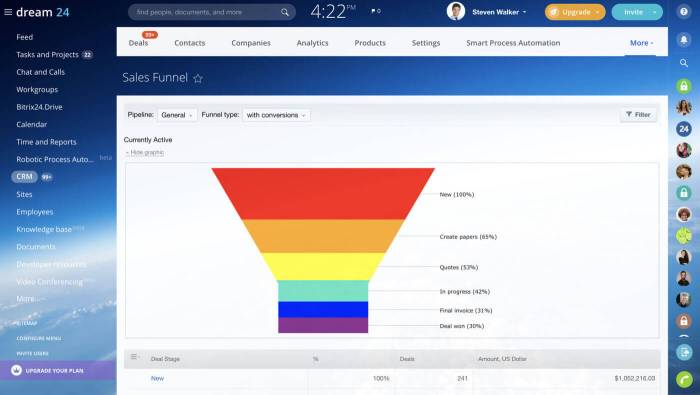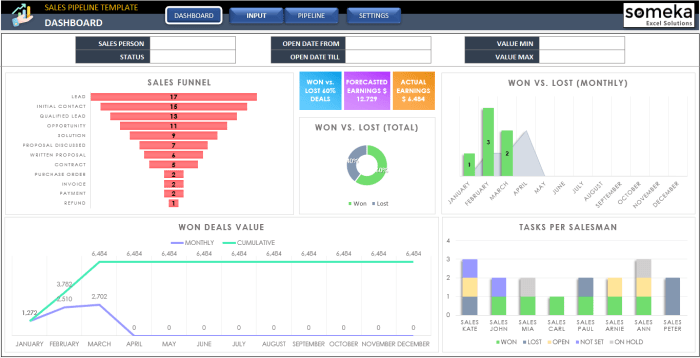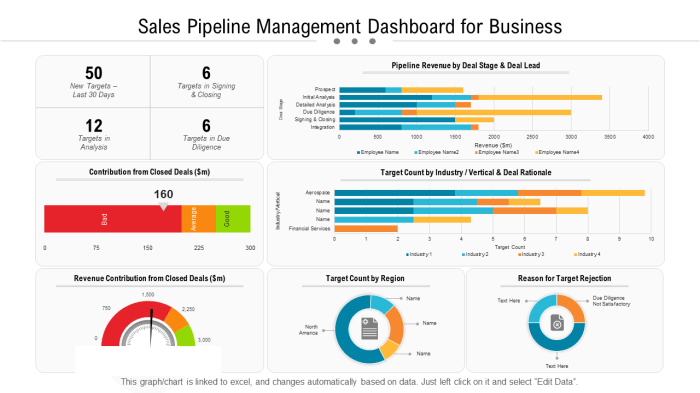CRM software with sales pipeline tracking offers businesses a powerful tool to visualize and manage their sales process. Understanding how each stage contributes to overall sales performance allows for proactive adjustments and improved forecasting. This comprehensive guide explores the core functionalities, benefits, and implementation strategies for leveraging CRM software to optimize sales pipeline management, ultimately boosting revenue and team efficiency.
We’ll delve into the various features offered by different CRM platforms, highlighting key considerations for selection and implementation. From customizing sales pipelines to analyzing performance metrics, we’ll equip you with the knowledge to make informed decisions and transform your sales approach.
Defining Sales Pipeline Tracking in CRM Software
Sales pipeline tracking within a CRM system provides a dynamic view of the sales process, from initial contact to final closure. It offers a centralized location to manage leads, opportunities, and deals, facilitating better organization and improved sales performance. This section will delve into the core functionality, typical stages, customization options, and visual representations of sales pipelines within CRM software.
Core Functionality of Sales Pipeline Tracking
At its core, sales pipeline tracking in CRM software automates the process of managing sales prospects. It allows sales teams to input and update information about each prospect, track their progress through the sales stages, and analyze key performance indicators (KPIs). This functionality streamlines sales processes, improving visibility and control over the sales cycle.
Typical Stages in a Sales Pipeline
A typical sales pipeline comprises several distinct stages, each representing a step in the sales process. While these stages can vary depending on the industry and business model, common stages include Prospecting, Qualification, Presentation, Proposal, Negotiation, Closing, and Follow-up. Each stage involves specific actions and milestones that contribute to moving a prospect through the pipeline.
Sales Pipeline Customization Across Business Types
Different business types tailor their sales pipelines to reflect their unique sales processes. For example, a SaaS company might have stages focused on free trial conversions and upselling, whereas a B2B manufacturer might focus on request for proposals (RFPs) and lengthy negotiation phases. A retail business, on the other hand, may have a simpler pipeline focusing on lead generation and immediate conversion.
Comparison of Sales Pipeline Visualizations
Various CRM systems offer different ways to visualize the sales pipeline. This table compares three common visualization methods.
| CRM System | Visualization Method | Strengths | Weaknesses |
|---|---|---|---|
| Salesforce | Kanban Board, Reports, Dashboards | Highly customizable, robust reporting | Can be complex for smaller teams |
| HubSpot | Pipeline view, deal stage tracking | User-friendly interface, good for smaller businesses | Limited customization options compared to Salesforce |
| Zoho CRM | Kanban, List view, Reports | Cost-effective, wide range of features | Steeper learning curve than HubSpot |
Benefits of Integrating Sales Pipeline Tracking
Integrating sales pipeline tracking into a CRM system offers numerous advantages, significantly impacting sales team performance, forecasting accuracy, and sales cycle length. This section will explore these benefits and address potential challenges in implementation.
Impact of Real-time Visibility on Sales Team Performance

Real-time visibility into the sales pipeline empowers sales teams to prioritize their efforts, identify potential deals at risk, and proactively address any roadblocks. This leads to increased efficiency, improved sales conversion rates, and better overall performance. Sales representatives can focus on deals with higher probabilities of closing, leading to increased revenue.
Improved Sales Forecasting Accuracy
Effective pipeline tracking allows for more accurate sales forecasting. By monitoring the progress of deals at each stage, businesses can predict future revenue more reliably. This enables better resource allocation, improved budgeting, and more informed business decisions. For instance, if a significant number of deals are stalled at a particular stage, management can intervene to identify and resolve the bottleneck.
Reducing Sales Cycle Length
By identifying bottlenecks and inefficiencies in the sales process, businesses can implement strategies to shorten the sales cycle. This could involve improving lead qualification processes, streamlining communication, or providing sales representatives with better training and tools. A shorter sales cycle translates to faster revenue generation and improved cash flow.
Challenges and Solutions in Implementing Sales Pipeline Tracking
Implementing sales pipeline tracking can present challenges, such as data entry inconsistencies, resistance from sales teams, and the need for adequate training. Solutions include establishing clear data entry protocols, providing ongoing support and training, and integrating the CRM system with other business tools to minimize manual data entry.
Key Features of CRM Software with Robust Pipeline Tracking: CRM Software With Sales Pipeline Tracking

Robust sales pipeline tracking goes beyond basic functionality, offering advanced features that enhance sales performance and provide deeper insights. This section will examine these key features, including visualization methods and reporting capabilities.
Differentiating Excellent from Basic Pipeline Tracking
Excellent pipeline tracking systems provide features such as customizable stages, automated workflows, predictive analytics, and robust reporting and visualization tools. Basic systems often lack these advanced capabilities, limiting their effectiveness in providing actionable insights and improving sales performance. For example, advanced systems might offer AI-powered lead scoring to prioritize high-potential leads.
Comparison of Sales Pipeline Data Visualization Methods, CRM software with sales pipeline tracking
Visualizing sales pipeline data is crucial for effective management. Kanban boards offer a visual representation of the workflow, while Gantt charts provide a timeline view, highlighting deadlines and dependencies. Choosing the right visualization method depends on the specific needs and preferences of the sales team. Some CRM systems offer both options, allowing for flexible data presentation.
Essential Reporting Capabilities for Sales Pipeline Analysis
Effective sales pipeline analysis relies on comprehensive reporting capabilities. Essential reports include win/loss analysis, sales cycle length reports, conversion rate reports, and revenue forecasting reports. These reports provide valuable insights into sales performance, enabling data-driven decision-making and continuous improvement.
Hypothetical Sales Pipeline Dashboard User Interface
A hypothetical sales pipeline dashboard could include a Kanban board displaying deals in different stages, key performance indicators (KPIs) such as conversion rates and average deal size, a sales forecast based on current pipeline data, and a customizable filter to segment data by sales representative, product, or customer segment. Real-time updates would ensure that the information is always current and accurate.
Choosing the Right CRM Software for Pipeline Management
Selecting the right CRM software is crucial for effective sales pipeline management. This section Artikels key criteria for selection, compares different platforms, and discusses integration and scalability considerations.
Checklist for CRM Software Selection
When choosing CRM software, businesses should consider factors such as ease of use, cost, integration capabilities, scalability, customization options, reporting features, and the level of support provided by the vendor. A thorough evaluation of these factors ensures that the chosen CRM system meets the specific needs of the business.
Comparison of CRM Platforms with Strong Pipeline Tracking
Salesforce, HubSpot, and Zoho CRM are popular choices, each offering robust pipeline tracking features. Salesforce is a powerful, highly customizable platform suitable for larger enterprises, while HubSpot is user-friendly and ideal for smaller businesses. Zoho CRM provides a cost-effective option with a comprehensive feature set. The best choice depends on the specific requirements and budget of the business.
Integration Capabilities for Seamless Data Flow
Seamless data flow between the CRM and other business tools is essential for efficient sales pipeline management. The CRM should integrate with marketing automation platforms, email marketing tools, and other relevant applications. This ensures that data is consistent across all systems, minimizing manual data entry and improving data accuracy.
Assessing Scalability and Customizability for Future Growth

Businesses should choose a CRM system that can scale to accommodate future growth. This involves considering factors such as the number of users, the volume of data, and the potential need for additional features or integrations. Customizability allows for tailoring the CRM system to meet the evolving needs of the business.
Optimizing Sales Pipeline Performance
Optimizing sales pipeline performance involves implementing strategies to improve efficiency, identify and address bottlenecks, and ultimately increase sales revenue. This section Artikels best practices and a step-by-step process for implementation.
Best Practices for Managing and Monitoring Sales Pipelines
Best practices include regular pipeline reviews, proactive identification and resolution of bottlenecks, consistent data entry, and utilization of reporting and analytics to identify areas for improvement. Utilizing sales pipeline dashboards and regular team meetings are crucial for monitoring progress and maintaining team alignment.
Identifying and Addressing Sales Process Bottlenecks
Bottlenecks can be identified by analyzing sales pipeline data, identifying stages with high drop-off rates, and conducting interviews with sales representatives to understand the challenges they face. Solutions might involve improving lead qualification, providing additional training, or implementing new sales tools.
Step-by-Step Process for Implementing a New CRM System
Implementing a new CRM system involves several steps: defining requirements, selecting a vendor, configuring the system, migrating data, training sales teams, and ongoing monitoring and optimization. Each step requires careful planning and execution to ensure a smooth transition.
Impact of Sales Pipeline Optimization on KPIs
A hypothetical chart illustrating the impact of sales pipeline optimization on KPIs would show an increase in conversion rates, a decrease in sales cycle length, and a corresponding increase in revenue. For example, before optimization, the conversion rate might be 10%, with an average sales cycle of 60 days and annual revenue of $1 million. After optimization, these figures might improve to 20%, 45 days, and $1.5 million respectively.
This would be represented visually with a line graph showing the pre- and post-optimization data points for each KPI.
Wrap-Up
Effectively utilizing CRM software with sales pipeline tracking provides a significant competitive advantage. By gaining real-time visibility into the sales process, businesses can identify bottlenecks, refine strategies, and ultimately achieve higher conversion rates. The ability to accurately forecast sales, shorten sales cycles, and improve team performance makes investing in a robust CRM system a crucial step towards sustainable growth and market leadership.
This detailed exploration of the topic empowers businesses to confidently choose and implement the right solution for their unique needs.
FAQ Insights
What is the difference between a sales pipeline and a sales funnel?
A sales funnel represents the entire customer journey, from awareness to purchase. A sales pipeline focuses specifically on the stages a sales representative manages within the sales process, typically within a CRM system.
How can I measure the effectiveness of my sales pipeline?
Key metrics include conversion rates at each stage, average deal size, sales cycle length, and revenue generated. Analyzing these metrics reveals areas for improvement and optimization.
What are some common challenges in implementing a CRM with sales pipeline tracking?
Challenges include data migration issues, user adoption resistance, integration complexities with existing systems, and the need for ongoing training and support.
Is it necessary to have a dedicated sales team to use CRM with sales pipeline tracking?
While beneficial for sales teams, even small businesses or solo entrepreneurs can utilize CRM for pipeline management to organize leads and track progress.
